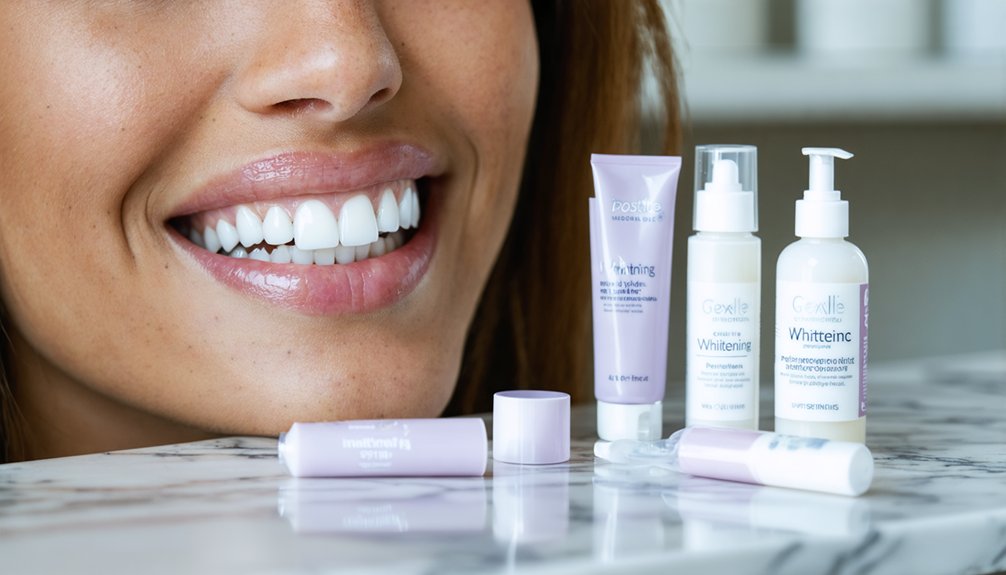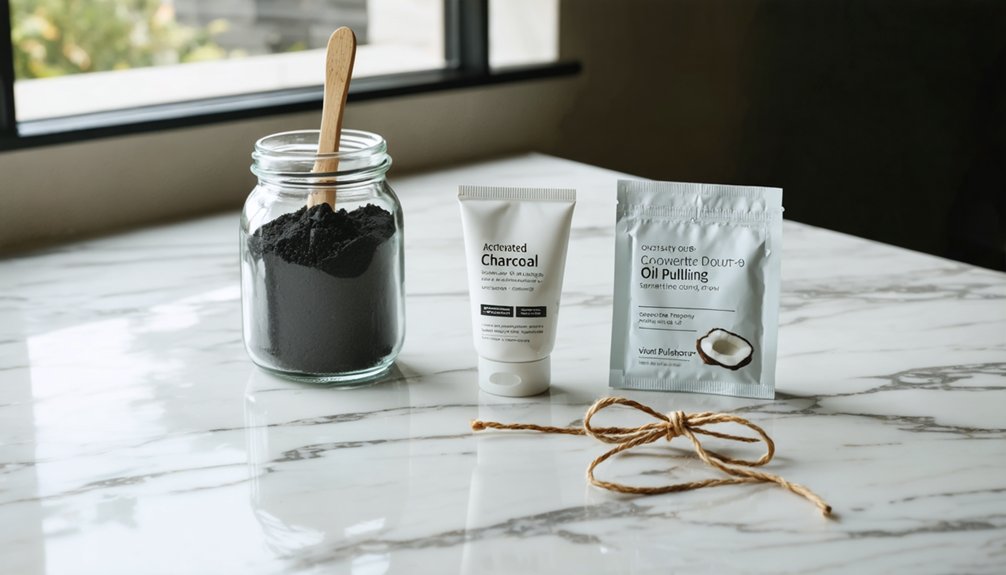If you have sensitive teeth, you can still achieve a brighter smile by choosing appropriate whitening methods. Select products with lower peroxide concentrations and built-in desensitizing agents like potassium nitrate and fluoride. Professional treatments offer controlled application, while at-home options provide gentler, gradual results. Use desensitizing toothpaste before and during treatment, and avoid temperature extremes. Understanding your options and following proper protocols will help you achieve ideal results while minimizing discomfort.
Key Takeaways
- Choose whitening products containing desensitizing agents like potassium nitrate and fluoride to minimize tooth sensitivity during treatment.
- Start with lower concentrations of whitening agents and gradually increase to allow teeth to adapt comfortably.
- Use custom-fitted trays from your dentist for even application and reduced gum irritation during at-home whitening.
- Apply desensitizing toothpaste daily for two weeks before starting any whitening treatment to strengthen tooth enamel.
- Consider professional whitening treatments, which offer controlled application and immediate oversight for sensitive teeth.
Understanding Teeth Sensitivity and Whitening
While teeth whitening can effectively remove stains and brighten your smile, it’s important to understand how the process can trigger tooth sensitivity. The active bleaching agents, hydrogen peroxide or carbamide peroxide, penetrate your enamel to break down stains. During this process, your teeth become temporarily more porous.
The whitening mechanics involve oxidation of stains, which alters both the enamel surface and underlying dentin. This chemical process exposes microscopic channels called dentinal tubules that connect to your tooth’s nerves. Modern whitening treatments often incorporate anti-sensitivity medication to minimize discomfort. Most patients experience sensitivity for days following their whitening treatment.
When these tubules are exposed, you’ll likely experience teeth sensitivity to hot, cold, sweet, or pressure stimuli. The good news is that this sensitivity is typically temporary, resolving as your teeth naturally remineralize and the tubules reseal through exposure to saliva and fluoride.
Safe Whitening Options for Sensitive Teeth
For individuals with sensitive teeth, selecting appropriate whitening methods requires careful consideration of both the active ingredients and treatment protocols.
Mindful ingredient selection and proven protocols are essential when choosing teeth whitening solutions for those with existing sensitivity.
You’ll find the safest options contain lower concentrations of hydrogen peroxide or carbamide peroxide combined with desensitizing agents like potassium nitrate and fluoride. Professional treatments, such as the Zoom Whitening System, offer controlled application and immediate oversight for ideal safety. These methods are particularly effective since they allow peroxide penetration while minimizing nerve responses.
When exploring natural alternatives, be cautious with abrasive substances that can damage enamel and worsen sensitivity. The procedure takes only 45 minutes total, making it an efficient choice for busy patients.
Instead, opt for gentler products specifically formulated for sensitive teeth, like Sensodyne Clinical White or Crest 3D White Gentle Routine.
Consider the long term effects by maintaining consistent oral hygiene and using desensitizing toothpaste before and after treatments to protect your enamel and minimize discomfort.
Professional vs. At-Home Whitening Methods
When choosing between professional and at-home teeth whitening methods, you’ll need to weigh several essential factors that impact both effectiveness and comfort.
Professional whitening offers higher-concentration agents and customized treatment under dental supervision, while at-home whitening provides convenience and gradual results at a lower cost. Products containing potassium nitrate can help minimize discomfort during the whitening process.
Key distinctions between these methods include:
- Professional whitening delivers faster results through concentrated bleaching agents and UV light activation
- At-home whitening uses lower concentrations, reducing sensitivity risks
- Professional treatments offer immediate monitoring for adverse reactions
- At-home options allow flexible application schedules and controlled exposure
For sensitive teeth, at-home whitening might be preferable due to its gentler approach, though professional guidance remains vital for best results. Dentists can provide custom take-home trays that offer excellent whitening results while maintaining comfort.
The choice ultimately depends on your sensitivity level, desired outcome speed, and budget considerations.
Best Practices for Minimizing Discomfort
To minimize discomfort during teeth whitening, implementing proper preparation and careful technique proves essential for sensitive teeth.
Begin with pre-treatment strategies, including daily fluoride use for two weeks to strengthen enamel and applying desensitizing toothpaste to block nerve signals. Choose products specifically formulated for sensitive teeth, using lower peroxide concentrations and limiting application duration. Consider using custom-made trays with your take-home whitening system for optimal results.
Protect sensitive teeth by strengthening enamel with fluoride and using desensitizing toothpaste before starting any whitening treatment.
For post-treatment care, avoid hot, cold, or acidic foods for 48 hours after whitening. Regular application of fluoride treatments will help strengthen and protect your enamel during the whitening process. Stick to room temperature water and soft foods while continuing with desensitizing toothpaste.
Use a soft-bristled toothbrush and gentle technique to protect your enamel. If sensitivity persists, space out treatments or consult your dental professional.
Remember to maintain regular dental hygiene with sensitive-formulated products throughout your whitening journey.
Managing Side Effects During Treatment
Managing side effects during teeth whitening requires a strategic approach to minimize discomfort while achieving desired results. When you experience sensitivity or irritation, implementing proper sensitivity management techniques can greatly reduce your discomfort. Monitor your symptoms closely and adjust your treatment accordingly. Over-the-counter pain relievers like ibuprofen can help manage tooth sensitivity and discomfort.
Key strategies for managing side effects include:
- Use desensitizing toothpaste before and during your whitening treatment
- Avoid consuming extremely hot or cold foods and beverages for 48 hours
- Reduce treatment duration if you experience persistent discomfort
- Contact your dental professional if sensitivity persists beyond one week
Remember that most side effects are temporary and typically resolve within 24-48 hours. Your hydration levels can impact sensitivity, so maintain adequate water intake throughout your treatment. Regular dental checkups are essential to monitor the overall health of your teeth and gums during the whitening process.
If you have pre-existing conditions like thin enamel or gum recession, work closely with your dentist to develop a customized sensitivity management plan.
Frequently Asked Questions
Can I Whiten My Teeth if I Have Dental Implants?
Like a painted ceramic vase, your dental implants won’t change color. You can safely whiten your natural teeth, but you’ll need professional guidance to guarantee they’ll match your implant’s shade.
How Long Should I Wait Between Whitening Treatments?
You’ll need to wait at least six months between professional whitening treatments. For at-home kits, maintain 3-6 month treatment intervals, and space over-the-counter whitening frequency every two months minimum.
Will Whitening Affect the Strength of My Existing Dental Fillings?
Pervasive peroxide can potentially weaken your filling materials’ bond strength and surface integrity. While most modern fillings maintain whitening safety, it’s recommended to consult your dentist before beginning any bleaching treatment.
Does Smoking Impact the Effectiveness of Teeth Whitening Treatments?
Yes, smoking considerably reduces teeth whitening effectiveness and extends treatment duration. You’ll experience faster re-staining and may need more frequent touch-ups to maintain desired results.
Can Medications Influence How Well Teeth Whitening Works?
Yes, certain medication types can greatly impact your whitening results. You’ll find that antibiotics like tetracycline cause intrinsic stains that are resistant to standard whitening products and treatments.
References
- https://www.snc.dental/blog/how-to-safely-whiten-sensitive-teeth/
- https://www.sensodyne.com/en-us/oral-health-tips/whitening-sensitive-teeth/what-to-know/
- https://www.44thstdental.com/how-to-whiten-sensitive-teeth/
- http://www.goochlanddentistry.com/whats-the-best-teeth-whitener-for-sensitive-teeth/
- https://rickoffdentistry.com/teeth-whitening/
- https://www.drbobsdentalcare.com/is-teeth-whitening-safe-for-sensitive-teeth/
- https://pmc.ncbi.nlm.nih.gov/articles/PMC4058574/
- https://www.ada.org/resources/ada-library/oral-health-topics/whitening
- https://harrisburgsmilesdental.com/why-does-teeth-whitening-cause-sensitivity-understanding-the-basics/
- https://www.wauwatosadentists.com/does-teeth-whitening-cause-tooth-sensitivity/



